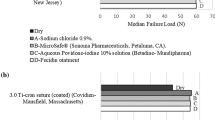Abstract
We produced a measurement apparatus for testing the tensile strength of wounds during cataract surgery, and tested the tensile strength of treated wounds including wounds sutured with various methods, non-sutured and wounds treated with various bio-tissue adhesives. Methods. In cataract surgery on white rabbits eyes, a corneoscleral incision 5 mm in length was made 2.5 mm from the limbus corneae, and entry into the anterior chamber was obtained 0.5 mm to the clear cornea. After treatment for closure, the corneoscleral piece was subjected to the tensile strength test. Results. The tensile strengths just after surgery were (1) 0 gf/mm2 after self-sealing sutureless closure; (2) 114 gf/mm2 after vertical suture closure (one stitch with 10-0 nylon); (3) 125 gf/mm2 after horizontal suture closure (one stitch with 10-0 nylon); (4) 143 gf/mm2 after infinity suture closure (with 10-0 nylon); (5) 112 gf/mm2 after fibrin glue (Beriplast®P) application (instilled on the surface of scleral incision); (6) 121 gf/mm2 after fibrin glue application (glued on corneoscleral wound); (7) 131 gf/mm2 after cyanoacrylate closure (instilled on the surface of scleral incision); (8) 139 gf/mm2 after cyanoacrylate closure (glued on corneoscleral wound). The respective strengths at four days after surgery were: (1) 86; (2) 131; (3) 137; (4) 175; (5) 109; (6) 43; (7) 138; and (8) 108 gf/mm2. At 28 days after surgery, the respective strengths were (1) 164; (2) 167; (3) 184; (4) 209; (5) 322; (6) 195; (7) 251; and (8) 175 gf/mm2. Conclusion. The use of fibrin glue in treatment of a wound in cataract surgery is beneficial in assisting this treatment.
Similar content being viewed by others
References
Shepherd JR. Induced astigmatism in small incision cataract surgery. J Cataract Refract Surg 1989; 15: 85–8.
Fine H. Chip-and-flip phacoemulsification technique with infinity suture closure. In: Yalon M (ed.) Techniques of Phacoemulsification Surgery & Intraocular Lens Implantation. Slack, Thorofare, NJ, pp 5–22, 1992.
McFarland MS. McFarland surgical technique. In: Gill JP, Sanders OR (eds) Small Incision Cataract Surgery. Slack, Throfare, NJ, pp 107–18, 1990.
Tensile strength. In: International chemical promotion.
Sakamoto R, Majima Y, Shigemitsu T, Yumiyama A, Ishiguro K. The intraocular toxicity of biological adhesive. Folia Ophthalmol Jpn 1994; 45: 133–6.
Foundation, ed. Kagaku daijiten (Encyclopedia of science). Maruzen Co. Lts., Tokyo, 1153 pp., 1985.
Inoue T, Kitaya T, Kobayashi T, Hayashi M. Adhesive effect of fibrin adhesive (Beriplast®) and its influence on spontaneous wound healing process. Oyo yakuri (Pharmacometrics) 1986; 31: 641–8.
Matsuda M. Wound healing and factor XIII. Nippon ketsuekigaku zasshi (Acta Haematol. Jpn.) 1977; 40: 995–1002.
Sato Y, Nakamoto M, Nakayoshi A et al. The use of antagosan in gastrointestinan surgery. Geka shinryo (Surgical Diagnosis & Treatment) 1977; 19: 1531–6.
Hilfenhaus J, Weidmann E. Fibrin glue safety: Inactivation of potential viral contaminants by pasteurization of the human plasma components. Arzneim-Forsch/Drug Res 1985; 35: 1617–9.
Author information
Authors and Affiliations
Rights and permissions
About this article
Cite this article
Shigemitsu, T., Majima, Y. The utilization of a biological adhesive for wound treatment: Comparison of suture, self-sealing sutureless and cyanoacrylate closure in the tensile strength test. Int Ophthalmol 20, 323–328 (1997). https://doi.org/10.1007/BF00176885
Accepted:
Issue Date:
DOI: https://doi.org/10.1007/BF00176885




